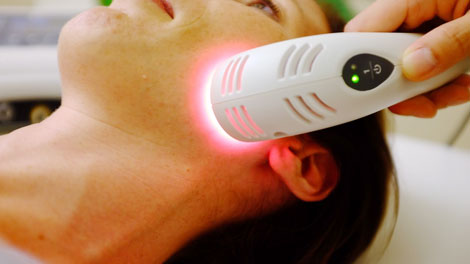EMG Feed Back
Biofeedback is the technique of using equipment to reveal to human beings some of their internal physiological events, normal and abnormal, in the form of visual and auditory signals in order to teach them to manipulate these otherwise involuntary or unfelt events by manipulating the displayed signals. [1] The ultimate purpose is that the patient gets to know his own body signs and that he can control them consciously. In first place using biofeedback equipment, afterwards even without....
Further, neuromuscular training or biofeedback therapy is an instrument-based learning process that is based on “operant conditioning” techniques. The governing principal is that any behavior-be it a complex maneuver such as eating or a simple task such as muscle contraction-when reinforced its likelihood of being repeated and perfected increases several fold. ...
Biofeedback as a component of treatment
It is important at the outset to emphasize that biofeedback is not at its most effective when used as a treatment in its own right, but should be integrated with other therapeutic interventions. It acts as an enhancer of the therapy, enabling the patient (and the therapist) to make more effective and rapid progress towards the rehabilitation goal. Furthermore, it is useful in that it helps the patient to reduce their reliance on the therapist and become more reliant on their own performance. Clearly this is not fully achieved if the patient becomes reliant on the machine instead of the therapist! It can be used effectively to enable the patient to take some control or ownership over their rehabilitation - empowerment is an often used phrase in this context. The key to success of biofeedback in rehabilitation is to use the device as an adjunct to therapy, to enable the patient to gain control without reliance on the therapist, and once gained, to maintain control without either the therapist or the machine. This approach is entirely in keeping with the general aim of modern physiotherapy, and the technology is an aid to the outcome, not a magical solution.
Indications
There are many indications for biofeedback. Stress urinary incontinence is an indication for biofeedback. We found in the literature that the addition of biofeedback to the training of the pelvic floor muscles for the treatment of stress urinary incontinence improved pelvic floor muscles function, reduced urinary symptoms, and improved of the quality of life.
Pelvic floor muscle exercises and biofeedback are also an effective treatment for men with erectile dysfunction.
Further we found that EMG therapy is useful in enhancing knee extension after an ACL reconstruction but only in the early phase of the rehabilitation after the reconstruction.
If we search evidence for biofeedback as the treatment for headaches we found that biofeedback-related approaches to headache therapy fall into two broad categories: general biofeedback techniques (often augmented by relaxation-based strategies) and methods linked more directly to the pathophysiology underlying headache.
The use of general biofeedback-assisted relaxation techniques for headache has been evaluated extensively. We can conclude that: various forms of biofeedback are effective for migraine and tension-type headache; outcomes with biofeedback rival outcomes with medication therapy; combining biofeedback with medication can enhance outcomes; and despite efficacy in many patients, biofeedback fails to bring significant relief to a sizeable number of headache patients.
Biofeedback methods that more directly target headache pathophysiology have focused chiefly on migraine and tension-type headache. These headache-specific approaches include blood volume pulse biofeedback, which has considerable supportive evidence, and electroencephalographic feedback. For tension-type headache we found that biofeedback was more effective than headache monitoring, placebo, and relaxation therapies. The strongest improvements were found for frequency of headache episodes. Further significant effects were observed for muscle tension. Biofeedback is also used for patients with migraine. This treatment is found effective to reduce the number of headaches per week but there were no change in intensity, disability and length of headache.
Other indications for biofeedback are:

